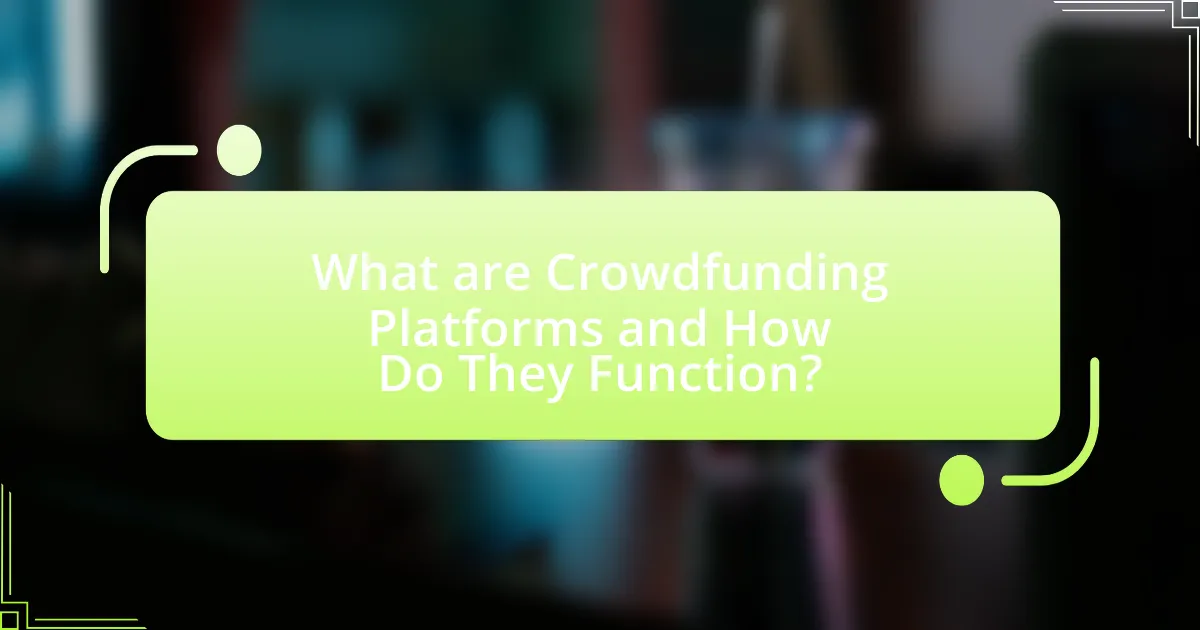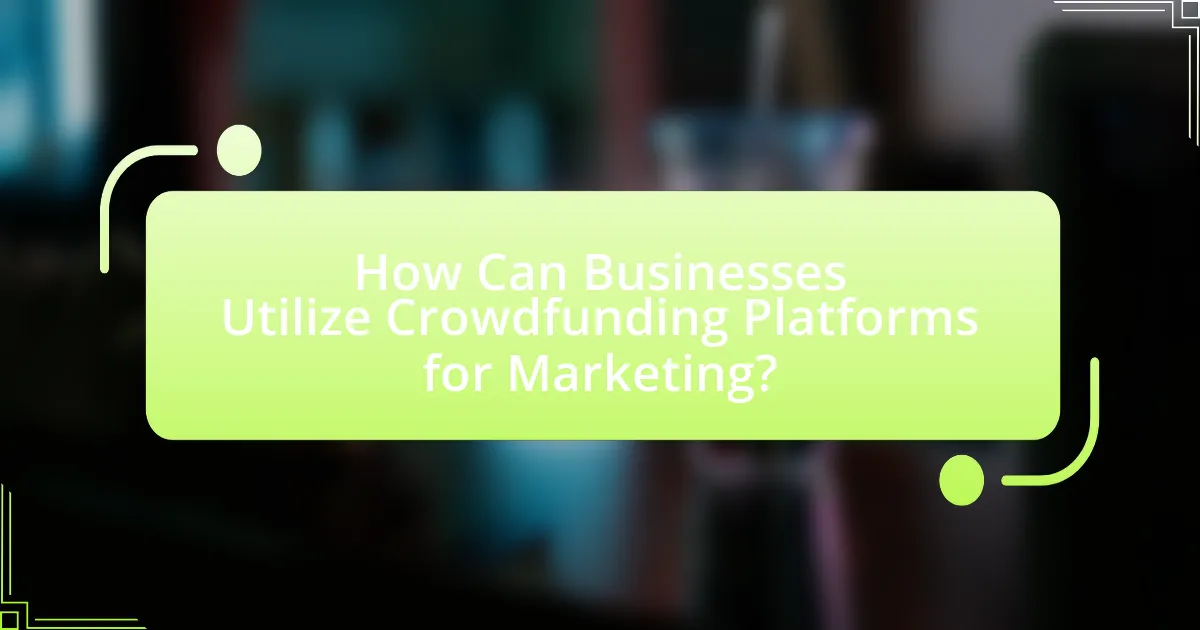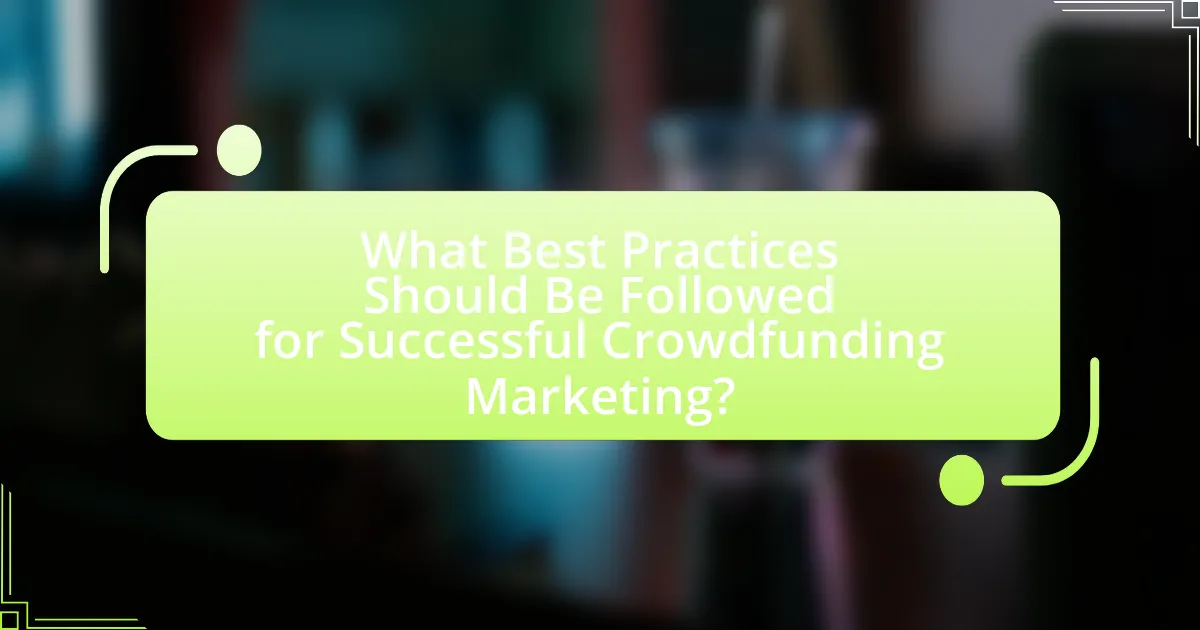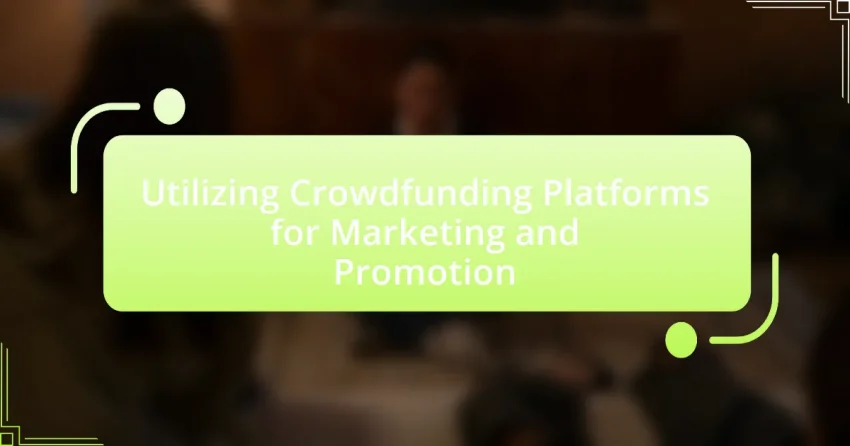Crowdfunding platforms are online services that enable individuals and organizations to raise funds for projects by collecting contributions from a large number of backers. This article explores the various types of crowdfunding platforms, including donation-based, rewards-based, equity-based, and debt-based models, and examines their operational mechanisms. It highlights the significance of community engagement, effective marketing strategies, and storytelling in enhancing campaign success. Additionally, the article discusses best practices for creating compelling content, maintaining backer communication, and managing expectations to maximize funding outcomes. Key insights into leveraging crowdfunding for marketing and promotion are also provided, emphasizing the importance of targeted outreach and clear messaging.

What are Crowdfunding Platforms and How Do They Function?
Crowdfunding platforms are online services that facilitate the collection of funds from a large number of individuals to support a project or venture. These platforms function by allowing creators to present their ideas or products to potential backers, who can then contribute money in exchange for rewards, equity, or other incentives. For example, platforms like Kickstarter and Indiegogo enable project creators to set funding goals and deadlines, while backers can choose to support projects they find appealing. According to a report by Statista, the global crowdfunding market was valued at approximately $13.9 billion in 2021, highlighting its significance in financing various initiatives.
What types of crowdfunding platforms exist?
There are several types of crowdfunding platforms, including donation-based, rewards-based, equity-based, and debt-based platforms. Donation-based platforms allow individuals to contribute money without expecting anything in return, often used for charitable causes. Rewards-based platforms offer contributors non-financial rewards, such as products or services, in exchange for their support, commonly utilized by startups. Equity-based platforms enable investors to purchase shares in a company, providing them with ownership stakes, while debt-based platforms allow individuals to lend money to businesses with the expectation of repayment with interest. Each type serves distinct purposes and caters to different funding needs.
How do donation-based crowdfunding platforms operate?
Donation-based crowdfunding platforms operate by allowing individuals or organizations to raise funds for specific projects or causes through contributions from the public. These platforms facilitate the process by providing a digital space where project creators can present their ideas, set funding goals, and share their stories to attract potential donors.
Typically, users create a campaign page that outlines the purpose of the fundraising effort, the amount needed, and any rewards or incentives for donors, although rewards are not always necessary in donation-based models. The platform then promotes these campaigns to its user base and beyond, often utilizing social media and email marketing to increase visibility.
As of 2021, platforms like GoFundMe and Kickstarter reported billions in total funds raised, demonstrating the effectiveness of this model in mobilizing community support for various initiatives.
What are the key features of equity crowdfunding platforms?
Equity crowdfunding platforms primarily feature the ability to raise capital by allowing multiple investors to purchase shares in a startup or business. These platforms typically include user-friendly interfaces for both entrepreneurs and investors, enabling easy navigation and investment processes. They also provide detailed project descriptions, financial projections, and business plans to inform potential investors. Regulatory compliance is another key feature, as these platforms must adhere to securities laws, ensuring that both investors and businesses are protected. Additionally, many equity crowdfunding platforms offer tools for investor communication and updates, fostering engagement and transparency throughout the investment period.
Why are crowdfunding platforms popular for marketing and promotion?
Crowdfunding platforms are popular for marketing and promotion because they provide a unique opportunity for businesses to engage directly with potential customers while simultaneously raising funds. These platforms allow creators to showcase their projects, gather feedback, and build a community around their brand, which enhances visibility and credibility. According to a study by Massolution, crowdfunding campaigns that effectively engage their audience can achieve funding success rates of up to 40%, demonstrating the platforms’ effectiveness in not only raising capital but also in promoting products and services.
How do crowdfunding platforms enhance brand visibility?
Crowdfunding platforms enhance brand visibility by providing a space for brands to showcase their products and engage with potential customers directly. These platforms attract a diverse audience, allowing brands to reach new demographics that may not be accessible through traditional marketing channels. For instance, a study by the University of Cambridge found that successful crowdfunding campaigns can increase brand awareness by up to 50%, as they leverage social sharing and community engagement to amplify their reach. Additionally, the interactive nature of crowdfunding encourages backers to share their support on social media, further increasing visibility and creating a buzz around the brand.
What role does community engagement play in crowdfunding success?
Community engagement is crucial for crowdfunding success as it fosters trust, builds a loyal supporter base, and enhances visibility. Engaged communities are more likely to contribute financially, share campaigns within their networks, and provide valuable feedback, which can improve project offerings. Research indicates that campaigns with strong community involvement raise 5 to 10 times more funds than those without, demonstrating the direct correlation between engagement and financial outcomes. Furthermore, platforms like Kickstarter report that projects with a pre-existing community often achieve their funding goals more quickly, underscoring the importance of community in driving crowdfunding success.

How Can Businesses Utilize Crowdfunding Platforms for Marketing?
Businesses can utilize crowdfunding platforms for marketing by leveraging the platform’s audience to generate awareness and validate their product ideas. By presenting their projects on crowdfunding sites, businesses can reach potential customers directly, allowing them to gauge interest and receive feedback before launching a full-scale product. For instance, successful campaigns on platforms like Kickstarter and Indiegogo often attract significant media attention, which can amplify marketing efforts and enhance brand visibility. According to a study by the University of Pennsylvania, projects that successfully funded on crowdfunding platforms saw an average increase of 20% in brand recognition and customer engagement, demonstrating the effectiveness of this approach in marketing.
What strategies should businesses adopt when using crowdfunding for marketing?
Businesses should adopt a multi-faceted strategy when using crowdfunding for marketing, focusing on building a strong narrative, engaging with the community, and offering attractive rewards. A compelling narrative captures potential backers’ attention and fosters emotional connections, which is crucial as campaigns with a strong story can raise up to 50% more funds than those without. Engaging with the community through regular updates and responding to inquiries builds trust and encourages sharing, which can amplify reach; studies show that campaigns with active engagement can see a 30% increase in funding. Additionally, offering well-structured rewards that align with backers’ interests can incentivize contributions, as campaigns that provide appealing rewards often achieve 20% higher funding success rates.
How can storytelling be effectively used in crowdfunding campaigns?
Storytelling can be effectively used in crowdfunding campaigns by creating an emotional connection with potential backers. This connection is established through relatable narratives that highlight the project’s purpose, the challenges faced, and the impact of the funding. For instance, campaigns that share personal stories or testimonials often see higher engagement; a study by Indiegogo found that campaigns with compelling narratives raised 20% more funds than those without. By weaving a story that resonates with the audience, campaign creators can inspire trust and motivate contributions, ultimately enhancing the likelihood of reaching funding goals.
What marketing channels complement crowdfunding efforts?
Social media platforms complement crowdfunding efforts by providing a broad reach and facilitating engagement with potential backers. These channels, such as Facebook, Twitter, and Instagram, allow creators to share updates, connect with their audience, and generate buzz around their campaigns. According to a study by Indiegogo, campaigns that actively engage on social media can see up to 50% more funding than those that do not utilize these platforms effectively. Email marketing also plays a crucial role, as it enables direct communication with supporters and can drive traffic to the crowdfunding page. Research indicates that personalized email outreach can increase conversion rates significantly, enhancing the overall success of crowdfunding initiatives.
What are the common pitfalls to avoid in crowdfunding marketing?
Common pitfalls to avoid in crowdfunding marketing include inadequate planning, lack of audience engagement, and poor communication. Inadequate planning can lead to unrealistic funding goals and insufficient marketing strategies, which often results in project failure; for instance, campaigns that set goals without thorough market research tend to fall short of their targets. Lack of audience engagement can alienate potential backers; campaigns that do not actively communicate with their audience or provide updates often see decreased interest and support. Poor communication, including unclear messaging about the project’s purpose and benefits, can confuse potential supporters, leading to lower contributions. According to a study by the University of Cambridge, campaigns that maintain regular updates and clear messaging are 50% more likely to reach their funding goals.
How can businesses manage expectations during a crowdfunding campaign?
Businesses can manage expectations during a crowdfunding campaign by clearly communicating goals, timelines, and potential outcomes to backers. Establishing a transparent narrative about the project’s vision and progress helps align backer expectations with reality. For instance, a study by the University of Pennsylvania found that campaigns with detailed updates and realistic funding goals are 30% more likely to succeed, indicating that clear communication fosters trust and engagement. Additionally, setting achievable milestones and providing regular updates can help maintain backer confidence and enthusiasm throughout the campaign.
What are the risks of over-promising in crowdfunding promotions?
Over-promising in crowdfunding promotions can lead to significant risks, including loss of credibility and potential legal repercussions. When project creators make unrealistic promises about product features, delivery timelines, or funding goals, they may fail to meet backer expectations, resulting in negative reviews and diminished trust. According to a study by the University of Pennsylvania, 30% of crowdfunding projects do not deliver rewards as promised, which highlights the importance of setting realistic goals. Additionally, if backers feel misled, they may pursue legal action, as seen in cases where creators have faced lawsuits for failing to deliver on their commitments. This combination of reputational damage and legal risks can severely impact future crowdfunding efforts and overall business viability.

What Best Practices Should Be Followed for Successful Crowdfunding Marketing?
Successful crowdfunding marketing requires a strategic approach that includes clear messaging, engaging visuals, and targeted outreach. Clear messaging ensures that potential backers understand the project’s value proposition, while engaging visuals, such as high-quality images and videos, capture attention and convey the project’s essence effectively. Targeted outreach involves identifying and connecting with specific audiences who are likely to support the project, utilizing social media, email campaigns, and influencer partnerships to maximize reach. Research indicates that campaigns with well-defined goals and a strong narrative are 50% more likely to succeed, highlighting the importance of these best practices in achieving crowdfunding success.
How can businesses create compelling campaign content?
Businesses can create compelling campaign content by focusing on storytelling, clear messaging, and audience engagement. Storytelling allows businesses to connect emotionally with their audience, making the campaign relatable and memorable. Clear messaging ensures that the core value proposition is communicated effectively, which is crucial in a crowded marketplace. Engaging the audience through interactive elements, such as polls or user-generated content, fosters a sense of community and investment in the campaign. Research indicates that campaigns with strong narratives can increase engagement rates by up to 300%, demonstrating the effectiveness of this approach.
What elements make a crowdfunding video effective?
An effective crowdfunding video includes a compelling story, clear visuals, emotional appeal, and a strong call to action. Compelling storytelling engages viewers by presenting the project’s purpose and impact, making it relatable and memorable. Clear visuals enhance understanding and retention, while emotional appeal connects with viewers on a personal level, increasing their likelihood of contributing. A strong call to action directs viewers on how to support the project, creating a sense of urgency. Research indicates that videos with these elements can increase funding success rates significantly, as they resonate more with potential backers.
How important is the design of the crowdfunding page?
The design of the crowdfunding page is critically important as it significantly influences user engagement and funding success. A well-designed page enhances visual appeal, improves navigation, and effectively communicates the project’s value proposition, which can lead to higher conversion rates. Research indicates that campaigns with professional and visually appealing designs can raise up to 50% more funds compared to poorly designed pages. Additionally, a study by the University of Pennsylvania found that projects with high-quality images and clear layouts are more likely to attract backers, demonstrating the direct correlation between design quality and funding outcomes.
What tips can enhance engagement with backers during a campaign?
To enhance engagement with backers during a campaign, maintain consistent communication through updates and personalized messages. Regular updates keep backers informed about project progress, fostering a sense of involvement and community. Personalized messages, such as thanking backers individually or addressing their comments, create a stronger connection and encourage further support. Research indicates that campaigns with frequent updates can raise 50% more funds than those with infrequent communication, highlighting the importance of engagement strategies.
How can regular updates impact backer trust and support?
Regular updates significantly enhance backer trust and support by fostering transparency and engagement. When project creators consistently communicate progress, backers feel informed and valued, which strengthens their emotional investment in the project. Research indicates that projects with frequent updates are more likely to meet or exceed funding goals, as backers perceive a higher level of commitment and reliability from creators. For instance, a study published in the Journal of Business Research found that backers are more likely to continue supporting projects that maintain regular communication, leading to increased funding and project success rates.
What methods can be used to thank and reward backers effectively?
To thank and reward backers effectively, project creators can implement personalized thank-you messages, exclusive rewards, and public recognition. Personalized thank-you messages, such as handwritten notes or tailored emails, foster a sense of connection and appreciation. Exclusive rewards, like limited edition products or early access to new features, incentivize backers and enhance their experience. Public recognition, through social media shout-outs or listing backers’ names on project websites, acknowledges their support and builds community. These methods are supported by studies showing that personalized communication increases donor satisfaction and loyalty, while exclusive rewards can boost funding success rates by up to 20%.
What are the key takeaways for leveraging crowdfunding platforms in marketing?
Key takeaways for leveraging crowdfunding platforms in marketing include understanding your target audience, creating a compelling narrative, and utilizing social media for promotion. Targeting the right audience ensures that your campaign reaches potential backers who are genuinely interested in your product or service. A compelling narrative engages backers emotionally, increasing their likelihood of contributing; successful campaigns often highlight personal stories or unique selling propositions. Additionally, social media serves as a powerful tool for driving traffic to your crowdfunding page, with studies showing that campaigns promoted through social media can raise up to 50% more funds than those that are not.
